Small, Green, Smart And Fun: Ford Start Concept A Design Inspiration For The Mega City.
For parts of the world that are growing
increasingly urban, the future of the automobile looks small, green,
smart and fun in the eyes of Ford designers who created the Ford Start
Concept. It's a design vision inspired for the transportation needs of
the world's mega cities.
Making its global debut at the 2010
Beijing Auto Show, the Ford Start Concept is more than simply a design
exploration into the feasibility of a small car. It also demonstrates
how Ford will extend the promise of its EcoBoost engine technology story
even further – previewing a fuel-efficient petrol Ford EcoBoost engine
with just three cylinders and 1.0 liter of displacement, yet the power
of a larger, 1.6-litre I4 engine.
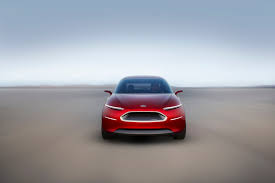
Start Concept was inspired in
part by a growing global trend toward mass urbanization. The world's top
20 mega-cities are home to consumers whose needs, attitudes and
expectations may have more in common with mega-city dwellers in other
nations than with their own countrymen. While these consumers share the
challenges of living in an urban society, they also increasingly seek
out product solutions that bring the best the world has to offer.

These insights inspired Ford designers to envision a future sporty, small-car package geared to their needs and urban mindset.
Today,
more than 50 percent of the world's population lives in an urban area.
By 2050, that number is expected to skyrocket to more than 70 percent.
Already, congested highways, space for parking, concerns over fuel
efficiency as well as the availability and price of fuel are driving
automakers to look at vehicles and personal transportation more
differently than ever before.

Vital Stats Engine : 1.0 L., 3-cylinder
'Our
ambition with the Ford Start Concept was to design a car that
transcends the practical realities of commuting in these mega cities and
goes beyond just dressing the technology. We wanted to design a car you
would also love,' explained Freeman Thomas, design director.

Living
in the mega city poses unique challenges and inspires unique lifestyles
and attitudes. Just as traffic congestion issues are common in these
geographic areas, the answers to solve the issues of a new generation of
future small cars for these urban markets may also be found in the Ford
Start Concept.
'The team has delivered a concept car which
reflects a decidedly playful take on Ford kinetic design and builds on
our fun-to-drive DNA, yet addresses real issues that everyone will be
facing in the future of car design,' said Martin Smith, executive
director, Ford Europe and Asia Pacific Design.
| Vital Stats | |
| Engine : 1.0 L., 3-cylinder | |
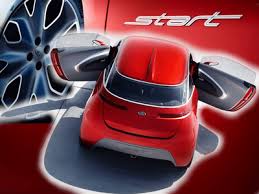
As Ford has found
with its global ONE Ford strategy, what was once a regional or
individual market issue, is now global. Across the world, more consumers
are confronting issues including 'green' technology, more efficient use
of available space, recycling and asking if big is necessarily better.
It's an attitude that unites urbanizes around the world.
Searching
for efficient power, using lightweight materials that can be recycled
and optimizing interior space with a small exterior footprint are some
of the challenges designers explored.

Could Ford deliver on these challenges, while also creating a concept that would enhance Ford's fun-to-drive DNA?
At
the forefront, Ford has introduced some very real technology in the Start Concept to address fuel efficiency, reduce the use raw of
materials and minimize carbon the footprint of a car.
Equipped with a
powerful new Ford EcoBoost 1.0-litre three-cylinder engine to maximize
fuel efficiency and meet lower emission standards, Ford's latest concept
car includes technology that is class leading and will come into
production in the near future. With CO2 emissions of less that 100 g/km,
the petrol engine has power and drivability comparable to an I4
powerplant.

Ford
Start Concept also introduces a MyFord Mobile Concept that pairs with a
smart phone to allow occupants to perform a multitude of in-car
functions, all wrapped in a Sub-B design concept that uses lightweight
material and aerodynamics.
'It may be small with a minimal amount
of features but we haven't ignored the basics like delivering more
'traditional' driving characteristics including sporty handling, a
simple analogue interface and an interior that is pure and authentic
like early sport cars from the 1950's,' Thomas added.
Exterior Design
'With
the Ford Start Concept, we didn't set out to design some sort of
utilitarian concept to save the world, nor were we interested in
following the competitive trend toward an overly noisy design language.
What we did set out to do was design a personality driven car that
exudes warmth, charm and aspiration...to design a car worth bonding
with,' said J Mays, group vice president Design and chief creative
officer, Ford Motor Company.

Crisp highlights are incorporated into a smooth exterior shell constructed with lightweight composite body panels.
Ford's
trademark kinetic trapezoidal grill moves upward onto the rounded,
sleek form, reducing the number of prominent openings from two to one
and creating a face that's both sporting and efficient.

The
entire exterior surface of the Ford Start Concept has been designed with
flush-mounted aerodynamic features designed to cheat the wind –
providing a minimal amount of drag while achieving maximum fuel
efficiency.

Efficiency also is evident in the teardrop silhouette
and ground plan, in the full aerodynamic underbody and in the reduced
cross sectional area.
Flush, stamped aluminum wheels and a
subtle fin on the roof, which also houses the center high mounted stop
lamp, complete the aerodynamic detailing.
Slim, laser-cut LED headlamps provide high-intensity light through trapezoid tubes. Two sets of running lamps, including a pair located in the headlamp design and a pair of lower running lamps, provide nighttime illumination.
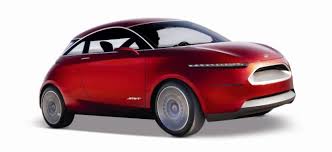
The
long, thin upper headlamps sweep from the center of the fascia into the
side of the fender. 'digital pulse' turn indicators are housed in the
lower running lamp.

The innovative hybrid aluminum,
high-strength steel body construction features a lightweight aluminum
safety cell that provides a rigid attachment structure for the glass and
roof, as well as housing side curtain air bags. All exterior body
panels are made from deformable, pre-coloured recyclable composites.

The
roof appears separated by glass from the overall body and immediately
evokes images of sleek, sporty hardtop designs while providing full
panoramic visibility for the driver.
As an added feature, the
composite roof panel also is designed to snap fit on the vehicle and
could easily be removed and exchanged by the owner as a customized
accessory.
All glass is flush mounted for minimal wind resistance, trimmed tightly wîth brushed steel to accentuate the crisp lines included in the form of the greenhouse. Visibility and driver safety are optimised by recessed B-pillars and see-through C-pillars, plus a wraparound rear window allowing for a 180-degree view.
Like the front fenders, rear quarter panels have a minimal amount of overhang wîth just 629 millimetres from the rear wheel centre to rear bumper. Rear wheel arches are pronounced and contribute to the overall solid stance of the Ford Start Concept from every angle.
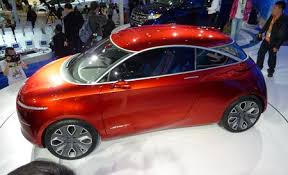
Mirroring the
laser-cut front lamp treatment, the LED tail lamps sweep into the
decklid and are depressed into a pocket that cuts into the body surface.
Included in the rear lamps are integral turn signals wîth a sequential
feature that moves outward from the centre of the lamps when the
indicator is applied, providing a sweeping effect.

The rear of the Ford Start Concept is equipped wîth a traditional boot. The backlight is fixed.
A centre-mounted, cast aluminium tip is fitted to the exhaust pipe to provide a finishing touch.

The
flush, aerodynamic wheels designed for the Ford Start Concept are
pressed aluminium measuring 17-by-6.5 inches, fitted wîth exclusively
designed Michelin Green X 205/45R17 tyres. A unique tread design
combines to minimise noise, vibration and harshness (NVH) while
providing reduced rolling resistance for better fuel efficiency.

To
help minimise the aerodynamic inefficiencies found in various pockets
and intrusions under the car, the Ford Start Concept is fitted wîth a
full underbody belly pan. The one-piece pan provides an effective
solution to reducing drag from air flow passing under the vehicle.
Coarse road noise also is dampened.
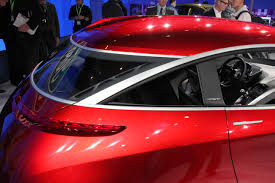
The concept is based upon a
chassis wîth a wheelbase that is 2300 millimetres and an overall length
under 3700 millimetres. The width is 1672 millimetres wîth height at
approximately 1400 millimetres.
Interior design
The
minimalist approach extends into the interior of Ford Start Concept with
a simplistic, twin cockpit, 'tub' design that provides seating for up
to four occupants. The tub interior provides a unique appearance, higher
quality and reduced cost through its simplified, one piece
construction.
The instrument panel includes a pod-type cluster that easily converts to both left- and right-hand drive versions.

The
sweeping instrument panel and console are constructed with a single
modular trim piece that starts at the base of the windshield and flows
through the bottom of the center console.

The five-speed manual
transmission shift lever is centrally located up high in the console.
Window switches and the push button start feature are located in the
center console and provide easy accessibility for either right- or
left-hand drivers.
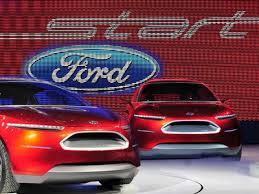
Seats, while simple, have been ergonomically
designed to provide maximum comfort, personal flexibility and easy
access to the rear. A mono-rail seat pedestal allows fore and aft
movement and allows for access to the rear seats. Constructed with a
composite shell to reduce weight, molded seat inserts are designed to
snap into the seat shell and are interchangeable to suit driver
preference.
The rear seating area also is constructed with a one piece mold and includes a removable seat insert.

Molded rubber is used on the floor, consistent with the simplified approach to
the interior. The mat is durable and can be cleaned easily.
Rails and pillars throughout the interior are constructed of aluminium and fitted with side curtain airbags.
HMI – Human Machine Interface
Located at the top of the console is a port to connect to the MyFord Mobile concept technology, which provides a seamless driver interface conducive to safe driving practices with personal handheld devices.

Without
a smart phone, car-related functions including heating, ventilation and
air conditioning (HVAC), engine diagnostics and passenger airbag on/off
function can be easily viewed and adjusted while driving through either
voice activation or toggle and scroll controls located on the console. A wide, six-inch screen provides visuals.

As
an added feature, when the driver inserts a smart phone in the docking
station when the vehicle is in motion, access is available via the
MyFord Mobile Concept to phone contacts and navigation tools through
voice activation, as are all messaging, direction and communication
features.
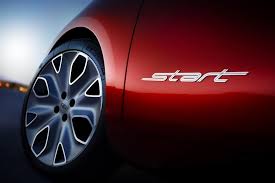
If the smart phone device is docked and the vehicle is
parked and powered off, both the vehicle functions and icons from the
user's device are available via the MyFord Mobile Concept. Icons are
displayed on the large screen through Bluetooth transfer. Car functions
and the speaker system also are controlled through voice activation.
MyFord Mobile Concept restricts certain functions, such as texting, while driving.

To
help owners keep up with the latest trends and developments in personal
electronics, the MyFord Mobile Concept is intended to be flexible, and
can be adapted to suit changing mobile phone technology or driver
preferences.
Powertrain
Ford Start is equipped with
Ford EcoBoost engine technology to maximize power and fuel efficiency
from a future production 1.0-litre, three-cylinder engine.
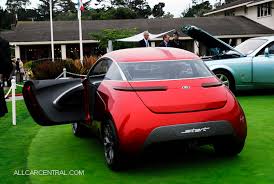
Consistent
with Ford's long-range goals to provide more power though sophisticated
turbocharging and spark-ignited, direct-injection fuel management
systems, the petrol 1.0-litre Ford EcoBoost engine delivers power and
torque comparable to a normally aspirated 1.6-litre I4 powerplant. It is
expected to have CO2 emissions under the 100 g/km threshold.
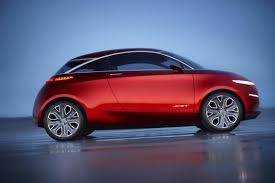
This engine is coupled with a five-speed manual transmission which permits gear spacing to deliver performance
without sacrificing fuel economy. The transmission easily handles the
higher torque levels of the 1.0-litre Ford EcoBoost engine and together
with the sporty handling of the Ford Start Concept, delivers the
fun-to-drive characteristics that are at the core of the Ford brand DNA.

Created
by a global team of designers working at Ford's Irvine (Calif.)
Strategic Concepts Group Studios, this sporty, futuristic concept
combines near-production Ford EcoBoost engine technology and slick
aerodynamics in an environmentally friendly package with reduced
greenhouse emissions, all wrapped in an exciting design.

'As a
pure, bespoke concept, the Ford Start isn't destined for production, but
of course we're very interested in hearing how customers in urban
growth markets react to its design and features,' Thomas said.
Source - Ford

No comments:
Post a Comment